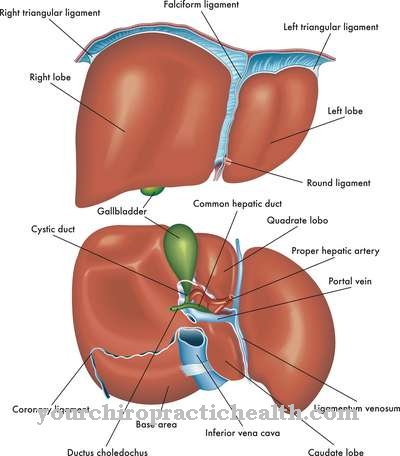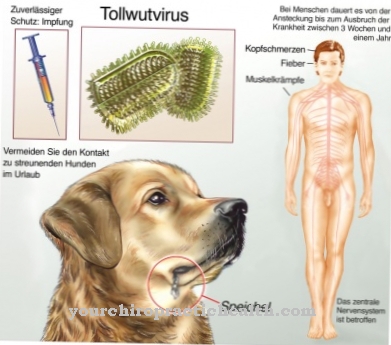At the Gollop-Wolfgang Syndrome it is a complex of malformations that is characterized by symptoms such as tibial aplasia or the characteristic cleft hand. The syndrome is believed to have a hereditary basis. Orthopedic, reconstructive and prosthetic steps can be considered as therapy.
What is Gollop-Wolfgang Syndrome?

© Kritchanut - stock.adobe.com
Gollop-Wolfgang syndrome is a congenital malformation of the extremities. The complex of symptoms was first described by the doctor Thomaz Rafael Gollop towards the end of the 20th century. A few years later, the American orthopedic surgeon Gary L. Wolfgang continued and added to this description. The symptom complex was named in honor of the two first descriptors.
The disease is a skeletal dysplasia that manifests itself in both the upper and lower extremities. The syndrome is characterized by a congenital absence of the tibia. This phenomenon is extremely rare. Across all diseases, fewer than one person in a million are affected by the symptom. The prevalence of Gollop-Wolfgang syndrome is correspondingly low.
Overall, the manifestations of the syndrome are extremely varied and can manifest themselves as a wide range of different symptoms. The syndrome usually involves the formation of a gap in the hand or foot, which is also known as ectrodactyly. The one-sided split hand is often associated with a one-sided fork on the thigh bone.
causes
So far, the cause and etiology of the Gollop-Wolfgang syndrome have not been conclusively clarified. This is mainly due to the low prevalence, which hardly gives research any starting point. Nevertheless, medicine is already more or less agreed on some of the connections between the syndrome. The malformations should rarely occur sporadically. A familial accumulation and thus a genetic basis is conceivable.
Whether an autosomal dominant or autosomal recessive inheritance is present has not yet been determined without a doubt. The question of a connection with a certain gene mutation and especially the question of the causative gene could not be answered so far. Causal factors that could promote the malformation in addition to the genetic factors are also unknown.
You can find your medication here
➔ Medicines for painSymptoms, ailments & signs
Patients with Gallop-Wolfgang syndrome show the full manifestation of the symptom complex immediately after birth. In most cases, the clinical features are multiple skeletal malformations affecting both the lower and upper limbs. In addition to the formation of a gap in a hand or foot, there is often a one-sided fork in the thigh bone, for example.
In addition to ectrodyctyly, a femur bifurcation in the sense of a bifurcation of the hollow organs can be recognized. In addition, there are often underdeveloped or completely absent appendages of the tibia. As part of oligodactyly, those affected usually also lack a finger or toe. This non-application can also affect several limbs of the hand or foot.
In some cases, in patients with Gollop-Wolfgang syndrome, this phenomenon extends to monodactyly in the sense of an integral part of the hands or feet. The bifurcation of the femur is usually one-sided. Presumably, significantly more malformations are conceivable in the context of the syndrome, which so far could only not be documented due to the few cases.
diagnosis
The diagnosis of the Gollop-Wolfgang syndrome is made by the doctor at the latest after the birth using visual diagnostics. In order to confirm the diagnosis, an imaging of the extremities can be carried out, which provides evidence of the multiple malfunctions. A prenatal diagnosis of the syndrome is also conceivable.
For example, modern sonography can detect malformations such as skeletal dysplasias before birth in the context of malformation ultrasound or fine ultrasound. The prognosis for patients with Gollop-Wolfgang syndrome is relatively favorable against the background of current prosthetics. Differential diagnosis should include hypoplastic tibial polydactyly syndrome and tibial aplasia-ectrodactyly syndrome.
Complications
The Gollop-Wolfgang syndrome leads to different malformations that can affect different regions of the body. In most cases, however, it is a malformation of the skeleton. It is not uncommon for a gap to form on the hands and feet.
In addition, the patient often misses toes or fingers on the limbs, which in many cases leads to a restriction in everyday life. The quality of life is considerably reduced by the Gollop-Wolfgang syndrome. Since the symptoms can be recognized immediately after birth, an early diagnosis and thus early treatment is possible.
However, the missing toes and fingers cannot be reconstructed, so that the person affected will suffer from these complaints for their entire life. For this reason, treatment is only symptomatic. If the limbs show very severe malformations, they can also be amputated. It is not uncommon for the patient to then rely on the help of other people in everyday life.
Psychological support is also often needed to avoid depression and thoughts of suicide. As a rule, intelligence is not influenced by Gollop-Wolfgang syndrome. Life expectancy does not decrease as a result of the syndrome.
When should you go to the doctor?
In the case of an inpatient birth, nurses and doctors automatically take over various examinations to check the child's state of health immediately after the birth. The doctors notice the malformation of the skeletal system and further examinations are initiated in order to be able to make the diagnosis.
In the case of a home birth, the midwife present notices the changes and abnormalities in the child's bone structure. She also automatically takes over the next steps and consults a doctor. Together we will clarify which more detailed investigations are necessary.
If the malformation is diagnosed in the womb, the doctor automatically prepares an inpatient birth. In these cases, individual birth planning for the well-being of mother and child takes place well before the due date.
If complications arise and a sudden delivery occurs without the presence of a midwife or doctor, a doctor must be called immediately after the birth. As soon as the malformation is noticed, an ambulance should be called so that it can be transported to a hospital as quickly and smoothly as possible.
Doctors & therapists in your area
Treatment & Therapy
There is no causal therapy for patients with Gollop-Wolfgang syndrome. The reason for this is the fact that the specific causes of the syndrome have not been conclusively clarified. Even if the causes were clarified, the only possible causal therapy would probably be gene therapy that has not yet been approved.
Treatment of the patient is therefore purely symptomatic. The most important goal of this symptomatic therapy is the establishment of independence. After the treatment measures, those affected should be able to live as independently as possible. Everyday activities should be hindered as little as possible by the symptoms that are still present. In connection with this objective, it is particularly crucial to improve patient mobility.
If, for example, the affected person cannot walk or grasp because of the malformation, amputation of the deformed limb can be considered in extreme cases. Such an amputation is followed by a prosthetic fitting, which will be all the more successful with appropriate training. Ideally, the fitting into the prosthesis, including the rehabilitation training measures, takes place in a rehabilitation center that specializes in prosthetics.
Together with a physiotherapist, those affected learn how to handle the prostheses and how to use them correctly in everyday life. The amputation and the subsequent measures can take months to years. Starting therapy as early as possible is advisable for many reasons. On the one hand, younger people learn how to use prostheses much faster than older people.
On the other hand, early care with prostheses can improve the psychological situation of those affected. In some cases, prosthetic therapy steps are not mandatory. Orthopedic and reconstructive measures are also often sufficiently successful in mild forms.
Outlook & forecast
Since the Gollop-Wolfgang syndrome is a genetic disease, there can be no complete or causal therapy. The person concerned is dependent on purely symptomatic treatment, which can partially limit the symptoms. Usually, the malformations on the extremities can be corrected in order to enable the patient to carry out a normal everyday life.
In severe cases, however, these must be amputated if correction is not possible. Prostheses are also often used to make everyday life easier. The movements can be partially restored with the help of physico-therapeutic exercises, but the person affected often depends on the help of other people in his or her life.
As a rule, the life expectancy of the patient is not negatively influenced by the Gollop-Wolfgang syndrome. The earlier the disease is diagnosed and treated, the higher the probability of a positive course of the disease.
In some cases, Gollop-Wolfgang syndrome can also lead to psychological complaints or depression. Bullying or teasing can occur, especially with children, so that children often need psychological treatment. Since Gollop-Wolfgang syndrome is a genetic disease, it may also be inherited.
You can find your medication here
➔ Medicines for painprevention
So far the Gollop-Wolfgang syndrome cannot be prevented because the causes have not been conclusively clarified.
Aftercare
In the case of Gollop-Wolfgang syndrome, the options for follow-up care are very limited. First and foremost, those affected depend on treatment of the malformations in order to prevent further complications. A complete cure of this syndrome is not possible, so that those affected are mostly dependent on lifelong therapy.
This may also significantly reduce the life expectancy of those affected. In many cases with Gollop-Wolfgang syndrome, contact with other patients with the syndrome is useful. This often leads to an exchange of information that can make life and in general everyday life much easier.
If those affected want to have children, genetic counseling can be useful. This may prevent the syndrome from being passed on to descendants. Most malformations are relieved by surgical interventions. After these procedures, those affected should rest and take care of their bodies.
You should always refrain from strenuous activities. Physiotherapy is also often required. Many of the exercises from this therapy can also be carried out in your own home to accelerate healing. Support from family and friends can also have a positive effect on the further course of Gollop-Wolfgang syndrome.
You can do that yourself
Since the Gollop-Wolfgang syndrome is a genetic disease, it cannot be treated by means of self-help. It is only possible to support the therapy and promote the mobility of the person concerned. However, this does not achieve a complete cure.
Due to the Gollop-Wolfgang syndrome, patients are generally dependent on permanent help in their everyday lives. This should be done warmly by your own family or friends. If the limbs have been amputated, the mobility of the affected person is encouraged by various therapies.
The exercises from physiotherapy or physiotherapy can often be carried out in your own home in order to speed up the treatment. As a rule, starting therapy early also has a very positive effect on the further course of the disease.
Children or young people should always be fully informed about the risks and complications of Gollop-Wolfgang syndrome in order to avoid psychological complaints or depression. Contact with other sufferers of the syndrome is also helpful, as this can lead to an exchange of information that can make everyday life easier.






.jpg)






.jpg)

.jpg)
.jpg)











.jpg)